
All Images
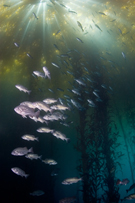
At depth, stands of giant kelp (Macrocystis sp.) are sparse. On the
water's surface, however, their lush canopy may permit only a few beams of
sunlight to pass. The surreal sensation of swimming just beneath the canopy as
these always dancing and occasionally blinding rays contrast with the shadows of
lurking blue rockfish (Sebastes mystinus) enchants almost all who
experience it. Environmental activist and long time dive boat captain Ed Cooper
was so taken with these lights that he named them "God beams". It's a fitting
appellation for one of many dive experiences that photograph poorly. This is
easily the closest I've come to capturing the feeling, but it lacks the sense of
immersion that comes with the real thing.
"Butterfly House", Carmel Bay, California
July 23, 2005
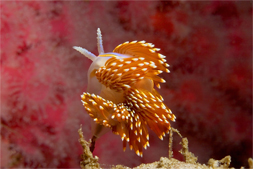
The cerata of this egg laying Hermissenda crassicornis are disheveled by
the water's surge, while its two annulate rinophores protrude upward. Visible in
the background is a colony of Corynactis californica that lines a cavity
in the tracks of a sunken World War II era amphibious landing tank. These
vehicles are commonly called "amtraks", a condensation of "amphibious tracked".
Hermissenda is one of many creatures in Monterey that, from time to time,
appear in large numbers. This specimen was one of perhaps several hundred that
had aggregated on one side of an amtrak.
"Mating Amtraks", Monterey Bay, California
July 9, 2005
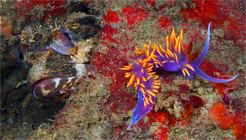
This spanish shawl (Flabellina iodinea) appears to be in danger of
becoming a colorful snack for a onespot fringehead (Neoclinus
uninotatus). Thankfully for the shawl, its wild coloration is indicative of
it's ability to sting potential predators. Spanish shawls rove the reef in
search of the hydroids upon which they feed. Interestingly enough, a shawl's
stinging ability comes from special cells called nematocysts which are captured
from prey and passed through the digestive system without being discharged. It's
possible that this fringehead wasn't interested in the passing slug because it
was familiar with its defense mechanism. However, I suspect that it's more
likely the fish was entirely unaware of its visitor. Fringeheads, apparently,
have poor eyesight. I've seen them out hunting -- they're quite prone to
mistaking rocks for prey.
"Anchor Farm", Monterey Bay, California
December 4, 2004
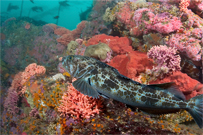
Being ambush predators, lingcod (Ophiodon elongatus) are relatively
tolerant of curious photographers. However, a fish that just sits on the bottom
often makes for a pretty boring picture. Thankfully, lingcod behavior is rather
predictable. With a little luck, one may be able to steer a ling into a desired
posture. This is one of my more successful examples of this. The biggest
challenge with such shots is getting the focus point correct. I have drawers
full of blurry lingcod pictures that I'm not going to show you. Another
difficulty when taking this kind of shot is that you usually only get one
chance. After that, the subject is sufficiently annoyed that you're going to
have a hard time getting close enough.
"East Pinnacles", Carmel Bay, California
January 23, 2005
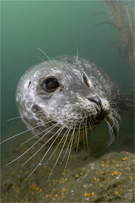
Always wary, harbor seals (Phoca vitulina) spend a great deal of time
scooting along, just a few inches off the bottom. Presumably, this makes it
difficult for predators and prey alike to detect their presence. Since the lens
used in this shot makes the subject appear farther away than it really is, it
may not have occurred to you to wonder why this animal, merely inches from the
camera's dome port is looking at something off to the photographer's right. If I
recall correctly, the animal came this close because it was attracted to the
port itself - they're very shiny underwater. While harbor seals seem to really
like camera ports, they have something of a love/hate relationship with strobes.
On the one hand, strobes such as the YS-90s I was using on this dive are, like
ports, shiny since their outer casings are transparent. On the other hand, they
emit terrible, scary flashes. About five minutes before this shot was taken, an
itchy trigger finger got the best of me and I pressed the shutter while this
seal was still about eighteen inches away. In this position, it was looking
almost directly into the strobes and winced in obvious annoyance. I cursed
myself for being so careless, but the damage was done. In this later shot, the
seal is actually looking at one of the strobes, I suspect with some concern.
Harbor seals are quick to learn how to avoid getting hit with strobes or focus
lights. Once educated, they may still tug on your fins, chew on an offered hand,
and even check out the non-flashy sides of strobes using the universal harbor
seal kiss of investigation (lips parted, mouth closed and pressed against the
object of interest). However, raise your camera, any you'll most likely end up
with nothing but the south end of a north bound seal. Should you find yourself
in such a position, It's time to turn off the camera and just enjoy the moment.
"Tanker Reef", Monterey Bay, California
November 27, 2005
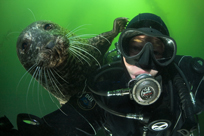
. . . and just when I was all set to take one of my very best self-portraits
ever, someone had to stick his nose in the shot and mess up everything! This
harbor seal (Phoca vitulina) is doing a pretty good job of pushing me
aside. Yes, those are his claws on my head. And yes, they're sharp and can be
felt through a drysuit hood, even the half-inch one I'm wearing. Note the
quarter-inch of water in the bottom of my mask. This is a side-effect of
roughhousing with the fuzzball -- or maybe it's just from an intense fit of the
giggles. This guy is quite the bully, actually. On this dive I'd spent over an
hour playing with a seal that was bit by bit working up enough the courage to do
something more than sneak up from behind to give a little fin tug. A few seconds
before this shot was taken, this original animal was chased off by the snarls of
the animal pictured. Proof, I guess, that competition in nature can be pretty
fierce, even in the pursuit of leisure -- and, I'm pretty sure this is what they
have in mind. Certainly, I'm sure they've figured out by now that my fins aren't
edible. You can't actually see my fins in this shot, you can clearly see some of
the other gear choices I've made (both good and bad). You'll have to indulge me
as I blab about dive gear for a bit. If you don't want to humor me in this
regard, well, then you can just move on to the next caption or something. First
off, photographers (artists that we are) often dress entirely in black. Clearly
that's what I'm doing. Black is pragmatic, (it doesn't show dirt and all), but
is a poor choice if you're going to be someone else's model. Everything black
gets swallowed up into one giant blob. Worse yet, every teeny, eeny, bit of
backscatter looks like a great big honking chunk when it's in front of a black
background. When choosing a color, consider blue, it looks great. My next suit?
Black with white speckles. Why? It's the only color in which the material I
wanted is available. At least, maybe the backscatter will be hidden among all
the speckles. The hood I'm wearing is a custom Otter Bay Wetsuits hood. Pure
genius, these hoods. You have no excuse for not owning one -- well, maybe if you
live in Nebraska you have an excuse, but certainly not if you're a diver, cold
or warm water. The one catch with the Otter hood is that it comes with a giant
Otter Bay logo. I could do without this, I consider it to be in much the same
league as license plate frames emblazoned with a auto dealer's name. I own dry
gloves which are bright blue -- again due to limited availability of colors.
While these have unintentionally made their appearance in far more than one shot
they thankfully can't be seen in a standard self-portrait like this one. This
mask is proof that the best gear is not always the most expensive. In fact,
apart from what you find at the drug store, this Oceanic Mini Shadow is about
the least expensive mask I've seen. If it fits you, buy one. If it doesn't
there's a non-mini version of the same mask so you might try that one. If that
doesn't fit either, then, well, too bad for you. I should admit that while I
don't represent Oceanic in any formal capacity, they have been paying customers
in the past. It's still a good mask, you have my word on it. Of course, I've
made some not-so-good gear choices also. Take the primary regulator I'm using
here (the thing in my mouth). It's plated with 100% pure unobtainium so it was
really spendy. Why? No reason, I just couldn't stand the thought that somewhere,
somehow, there might maybe be someone with more expensive gear than mine. Dive
gear manufactures are fond of such gimmicks. With a little bit of rational
thought (hard for some of us, I know) it shouldn't be too hard to avoid most of
these.
"Tanker Reef", Monterey Bay, California
October 22, 2006
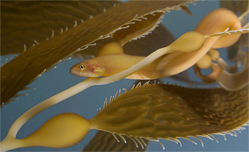
One of the more cryptic denizens of the Monterey bay, kelp gunnels (Ulvicola
sanctaerosae) like this one often display remarkable tail dexterity. If one
is fortunate enough to see this animal at all, it can be quite difficult to
visually trace it from end to end due to it's ability to wrap its tail in
improbably tight coils around stipes of kelp. Small animals that hide in giant
kelp almost universally use the same, very simply, mechanism to deter predators
(and photographers). When discovered, they simply move to the back side of the
stipe on which they're resting. Easy for them, they only have to move a tiny
bit, but a predator/photographer has to move several feet in order to regain
their original view. Of course, what works once, works twice or three times as
well, and you can imagine who usually gets the upper hand in this exchange. I've
tried rolling the kelp's thallus in my fingers to present subjects to the
camera, it doesn't work as well as you might think. The classic solution to this
problem is to place a hand on the backside of the stipe to scare the subject to
the camera side. This works somewhat for wide angle shots if you can get your
scaring hand out of the shot before the subject slips behind the stipe again. It
doesn't work well for macro since it's quite difficult to keep the camera rig
steady with one hand.
"Tanker Reef", Monterey Bay, California
December 4, 2005
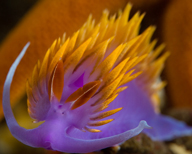
The vibrant colors of a Spanish shawl (Flabellina iodinea) provide
photographers with great raw material. Of course, there's always a catch: These
inch-long slugs flap violently in the surge like one of those cat toys made from
rubber bands on the end of a stick. As such, getting the rhinophores in focus is
often an exercise in frustration. Even a really good macro lens has difficulty
autofocusing on this type of subject. This shot was taken using a fixed focus
and fine movements of the photographer's hand to achieve focus by moving the
entire camera forward and backwards. The blurry orange arms are those of a blood
star (Henricia leviuscula).
"Shale Island", Monterey Bay, California
February 17, 2007
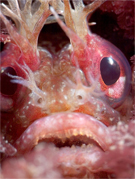
Yellowfin fringeheads (Neoclinus stephensae) have the best coiffure on
the reef. This animal has chosen a conspicuous patch of reef in which to make
his home. As such, it's easy to find. I usually drop by if I'm in the
neighborhood. As with most fringeheads, it's an almost sure bet that it'll be
home. This consistency peaked my curiosity. I wondered if these fringeheads are
exclusively ambush predators or if they sneak out under cover of darkness to
find themselves a meal. Naturally, I paid a visit one day at about one AM. The
hole appeared empty, but to be sure, I illuminated its interior. What I saw was
one perturbed looking eye and a big head of hair withdrawn well into the bore.
Oops! Sorry man.
"Shale Island", Monterey Bay, California
March 19, 2006
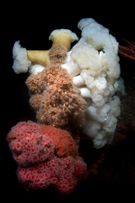
A column of anemones. From top to bottom: giant plumed anemones (Metridium
farcimen), yellow zoanthids (Epizoanthus scotinus), and club-tipped
anemones (Corynactus californica). This is an example of how strobe
lighting can be used to manipulate how the human eye and brain perceive a scene.
In this case the strobes were set to make the Metridiums appear higher
off the bottom than the Corynactus. This isn't actually the case. The
subject's true orientation actually makes it look rather unphotogenic. I was a
little slow to realize how pretty this column is, and, oddly enough, this shot
was taken more out of frustration than anything else. The sole purpose for this
dive was to take pictures of a subject about three feet away. These pictures
didn't turn out nearly as well as I had hoped and I switched to taking shots of
this anemone column to console myself.
"Deep Shale", Monterey Bay, California
April 16, 2005
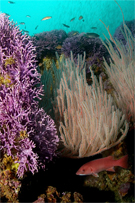
As is typical of wrasses, California sheephead (Semicossyphus pulcher)
begin life as females, but may transform into males in later life. Here, a
demure female seeks the shelter of a red gorgonian (Lophogorgia
chilensis). It's a several hour ride from Los Angeles harbor to Farnsworth
Bank. The long ride, coupled with the time the night before spent in heavy I-5
traffic rather than sleeping, took its toll the day I shot this image. In fact,
I can't ever remember being more miserable out on the water. The day's dives
themselves were clumsily executed, but enjoyable nonetheless. The end of the
second dive coincided with the start of distressingly brisk wind which made the
trek to the night's anchorage a long one. The ascetic accommodations on the
whaler'sanchor locker were never more welcome.
"Farnsworth Bank", Santa Catalina Island, California
April 2, 2005
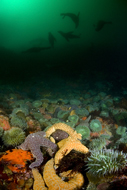
California sea lions (Zalophus californianus) are perfectly at home in
heavy surf. In fact, this rowdy bunch (and, yes, that's a technical term) seems
oblivious to the nearby boiling whitewater (the dark area at top left). Neither
photograpers nor cameras fare as well, but both sometimes venture into such
places in search of good shot. While much of Lobos Rocks is exposed, these ochre
stars (Pisaster ochraceus) and giant green anemones (Anthopleura
xanthogrammica) are found only in a narrow valley on which the ocean's
greatest anger is focused (natch).
"Lobos Rocks", Big Sur, California
August 6, 2006
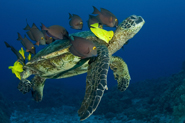
Green sea turtles (Chelonia mydas) seem to really enjoy taking time out
to get cleaned. These gold-ring surgeonfish (Ctenochaetus strigosus) and
yellow tangs (Zebrasoma flavescens) eek out a living nibling at algae
that grows on the reef. You can imagine their excitment when a turtle who's been
out at sea arrives sporting a shell with a lush carpet of algal growth. This
turtle has an injured flipper. Monofilament fishing line and other refuse create
entanglement hazards for a wide variety of marine animals, turtles included.
"Kona", Hawaii
January 6, 2007
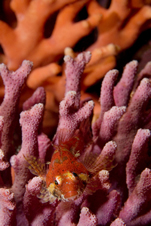
A scalyhead sculpin (Artedius harringtoni) that appears to be fairly
adept at crossing its eyes. This animal's camouflage is defeated by the backdrop
of California hydrocoral (Stylaster californicus). However, there is an
abundance of potential prey hiding within the hydrocoral branches which may make
the risk of venturing out into plain view one worth taking.
"East Pinnacles", Carmel Bay, California
October 8, 2006
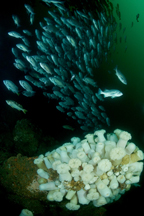
Blue rockfish (Sebastes mystinus) are Monterey's most interesting
schooling fish, particularly when they pack into large, dense aggregations like
this. The corner to corner angle of view in this shot is a full 180 degrees, but
even so, it seems a little too narrow. Super wide angle lenses are, of course,
great for the underwater photographer since they allow pictures of large reef
scenes unobscured by particulate matter in the water. At some point, however,
things start getting difficult. With my current lens, I have to be careful to
keep hands and elbows out of the shot. With a lens that was wider still, I
suspect I might have to -- as a friend of mine has suggested -- tape back my
ears or something. While big schools like this can still be found in more remote
places, it's quite unusual to see something like this in areas that are under
heavy fishing pressure. Actually, in many hundreds of dives in Monterey bay,
this is the only such school I've seen. That this school was considerate enough
to swim next to a big bunch of Metrdidium farcimen was an added bonus.
I'm a extra fond of this picture because it's the only reasonably good shot I've
taken while swimming backwards. "Backwards?" you say. Yes, as it turns out, one
of the charms of the 60's era Scubapro fins I use is that they are particularly
well-suited to swimming backwards. It's something that takes a bit of practice,
but is not so unreasonable as it sounds. And, no, there are no hands involved in
this backward swimming. All this being said, it's most often used to get oneself
out of a tight spot when current or surge is about to smash one into the end of
a narrow hole or crack in the reef. In such situations I'm usually more worried
about scratching my camera port than I am about getting a shot. In this case
however, I was able to correct for an initial overshoot in approaching the
subject. Hopefully this means I've managed to add one more item to my bag of
photographic tricks.
"Ballbuster", Monterey Bay, California
October 15, 2006
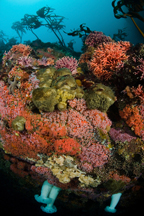
Up or down? Having been quite disappointed by Canon's 15mm fisheye lens, I
picked up Sigma's version. So far, it looks like the new toy adapts to
underwater life much better than does the Canon. I suspect there will be a used
Canon fisheye going up for sale on eBay soon. This shot contains nothing more
than the usual Carmel Bay subjects: California hydrocoral (Stylaster
californicus), Corynactis californica, and Metridium farcimen.
However, I like it because of the lighting -- actually, the lack of lighting in
the bottom of the shot and that the Metridiums don't seem to need any
illumination to show up just as saliently as they always do. It almost seems
like the bottom of the shot is some sinister complement to the heavenly blue
water at the top. I suspect this picture wouldn't have been nearly as successful
if taken on a day when Carmel Bay's water was its more usual green.
"Outer Pinnacles", Carmel Bay, California
January 28, 2007
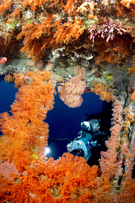
Clinton Bauder peers into the wheelhouse of the FS-172 Boston. Likely the
swift current is at least partly responsible for the beautiful soft corals
adorning this wreck. Perhaps this strong current, or the way it swirls through
the cavities in the ship also explains why the small fish in this image are
swimming upsidedown! While jumping in the water for a dive is often magical in
that one is instantly transported to an enticing and fantastic environment, the
experience of this dive seems to have been turned on its head. It is not the
start of the dive that sticks in my mind, but the end. At shallow depths, the
crystal blue water seen in this picture turned to a turbid white that concealed
even my own feet. On the surface, wind screamed and waves broke with fury on the
lava rocks not more than fifty feet away. Confusion seemed to abound and I
scrambled to doff equipment and climb into the inflatable, all while minding the
danger of the near by beach. In the midst of this, like some beam of sun in a
tempest, children from some local village, laughed and waved to me from the palm
trees behind the breakers. Despite my discomfort in my situation, I couldn't
suppress a return wave. During my entire time in New Guinea, local adults and
children alike trailed after divers, expressing deep fascination, perhaps even
awe. At no other time, however, was the barrier of the fishbowl in which we were
watched broken. Yet it seemed to have been broken by this simple wave.
"Wewak and Madang", Papua New Guinea
August 21, 2005
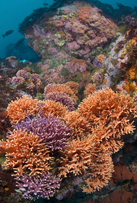
I love the way California hydrocoral (Stylaster californicus) spills over
this ledge. This is surely the shot that took the most attmepts before achieving
a presentable image. It doesn't look like a particularly difficult subject, but
the combination of turbulent water and the somewhat problematic geometry led to
a string of disappointing pictures. Interestingly enough, another photographer's
picture of this same patch of coral was one of the driving forces behind my
decision to take up underwater photography. And, coincidently, I acquired my
first housed camera from that photographer's spouse!
"East Pinnacles", Carmel Bay, California
May 15, 2006
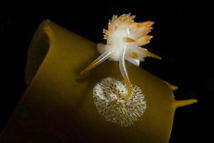
This ant-sized three-lined aeolid (Flabellina trilineata) can move
surprisingly quickly. One doesn't usually think of slugs as particularly speedy,
but if you pick up a camera, you'll likely notice that your shot's composition
changes much faster than you might like. In fact, I was much chagrined by my
first attempt to photograph the beautiful and unusual Aeolidea papillosa.
Simply put, I was, well, outrun -- or, outslithered to be perfectly accurate.
You might notice that there are still no pictures of this animal on the site.
"McAbee Beach", Monterey Bay, California
July 16, 2006
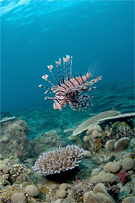
Lionfish (Pterois sp.) like this one are poor swimmers. For defense they
rely upon their large array of venomous spines rather than their speed. Once a
lionfish has been discovered, it's usually not difficult to get quite close to
it. However, obtaining a pretty photograph is a bit of a challenge since
lionfish usually stay quite close to some benthic structure and often turn their
tail (and thus the points of their spines) toward their observer. Patience and
careful body positioning may be required to get a shot that has a uniform
background that will nicely highlight the lionfish's complex silhouette.
"Wewak and Madang", Papua New Guinea
August 20, 2005
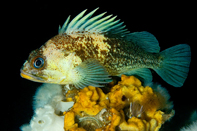
Oddly enough, this quillback rockfish (Sebastes maliger) is positioned
such that his nose is pointing directly up. I've taken the liberty of displaying
him in a more reasonable orientation.
"Hussar Point", Browning Pass, British Columbia
September 5, 2006
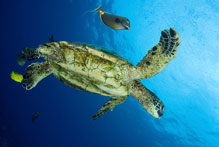
Green sea turtle (Chelonia mydas) and orangespine unicornfish (Naso
lituratus). Turtles really do look pretty goofy when they swim.
"Kona", Hawaii
January 6, 2007
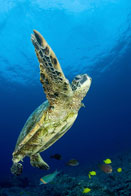
This green sea turtle (Chelonia mydas) appears to be giving me a
one-flipper salute. Hmmm. well, anyway one of the odd habits of turtles is that
the seem to see nothing wrong with swimming so close to something that they
whack it with their flippers. True to form, I got a bonk on the head about a
half second after this shot was taken.
"Kona", Hawaii
January 6, 2007
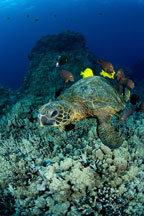
Green sea turtle (Chelonia mydas).
"Kona", Hawaii
January 6, 2007
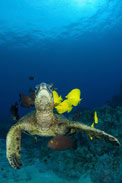
Green sea turtle (Chelonia mydas), gold-ring surgeonfish (Ctenochaetus
strigosus) and yellow tangs (Zebrasoma flavescens).
"Kona", Hawaii
January 6, 2007
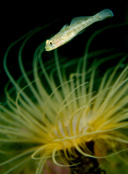
No, nothing untoward has been done with the color of this tube anemone
(Pachycerianthus fimbriatus). The occasional specimen is actually bright
orange and has something of a phosphorescent glow. Much of this is lost under
strobe lighting -- what you see here is what remains. I don't think blackeye
gobies (Coryphopterus nicholsi) have any special affinity for tube
anemones, but both are often found at the boundary between reef and sand.
"The Barge", Monterey Bay, California
June 17, 2006
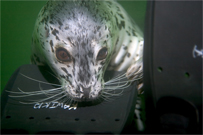
Photographer's fins and a furry dive companion with a foot fettish. A harbor
seal (Phoca vitulina) may introduce itself by biting and pulling on a
diver's fins. The pull feels quite similar to entanglement in kelp. This,
coupled with the fact that these animals are quite capable of vanishing from
view faster that one can turn around has often led me to wonder if I was having
hallucinations. I've felt tugs three, four, five times during a dive, before
catching a glimpse of the culprit. Eventually, the nibbler may work up the
courage to move beyond just fins. I've had seals tuck themselves under my arm,
or mouth hands, lights, and camera strobes. On several occasions I've even seen
them belly up in front of me in seeming demand of a tummy rub. Harbor seals seem
to treat contact with their own swimming flippers (though not their forward,
steering ones) as a sign of aggression. Perhaps this isn't surprising since a
seal with disabled hind flippers would almost certainly be unable to hunt and
would therefore perish. It may then be that fin nibbling is some kind of mock
dominance or a way to test the disposition of unfamiliar creatures. It may also
be that these young animals are simply practicing a defense skill that they'll
use throughout their lifetime. On one occasion, I was chased off -- away from
what, I'm not entirely sure -- by an adult harbor seal who nipped at my ankles
(not fins) with real force.
"Tanker Reef", Monterey Bay, California
September 4, 2005
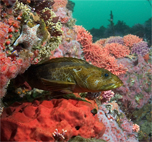
A somewhat drab lingcod (Ophiodon elongatus) departs a crevice framed by
a leather star (Dermasterias imbricata) and an unidentified red sponge.
"East Pinnacles", Carmel Bay, California
July 3, 2005
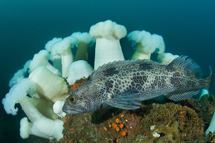
Large lingcod (Ophiodon elongatus) are seldom seen in areas under heavy
fishing pressure. At Hopkins Deep Reef, one encounters mostly runty ones like
this. Though, the fisherman's heartbreak may be the photographers joy: small
lingcod are nicely proportioned against a backdrop of Metridium
farcimen.
"Hopkins Deep Reef", Monterey Bay, California
January 21, 2007
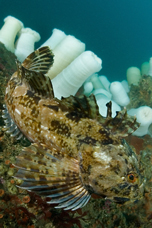
A cabezon (Scorpaenichthys marmoratus) on the move. This guy appears to
have an injured dorsal fin.
"Hopkins Deep Reef", Monterey Bay, California
January 21, 2007
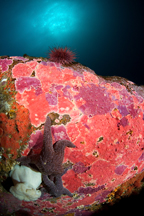
Encrusting hydrocoral (Stylantheca porphyra) and noon sun.
"Middle Farallon", Farallon Islands, California
February 3, 2007
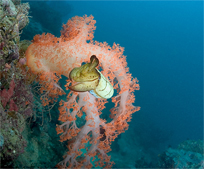
Broadclub cuttlefish (Sepia latimanus). Like octopuses and squid,
cuttlefish are cephalopods. Like their more commonly known cousins, cuttlefish
swim in the opposite direction that they're looking. Here one makes a methodic
retreat to the back side of a soft coral.
"Wewak and Madang", Papua New Guinea
August 22, 2005
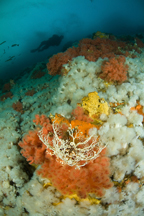
Basket stars (Gorgonocephalus eucnemis) can be found clinging to Browning
Wall's masses of Gersemia rubiformis and Metridium senile.
"Browning Wall", Browning Pass, British Columbia
September 5, 2006
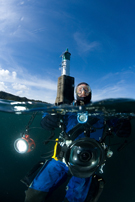
Clinton Bauder waits for a pick-up in front of the Dillon Rock beacon. You may
notice Clinton in an awfull lot of my shots. Yes, I live in San Francisco, but
no, I don't have a "special affinity" for Clinton. In truth, it's not easy to
find someone with the dive skills needed to be a good model. Clinton's certainly
a good guy, but I think I'd prefer a blonde with big bashfull eyes that are
striking, even through dive gear -- provided, of course, she could hold a 10 ft.
stop with aplomb.
"Dillon Rock", Shushartie Bay, British Columbia
September 6, 2006
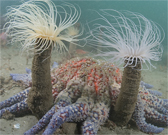
A sunflower star (Pycnopodia helianthoides) slides a few arms between a
pair of tube anemones (Pachycerianthus fimbriatus). This is a good
example of how a photographer can intentionally mislead his audience. In this
case the image leads one to believe that the Pycnopodia is stuck or, at
least, thwarted in its attempt to travel toward the camera. Deceptions like this
are one of the reasons I prefer still photography over video. A more "honest"
depiction of a scene like this might involve the Pycnopodia, a swift
moving, voracious predator, mowing down everything in its path, tube anemones
included. Silt-bottom environments, like the one in which this shot was taken,
present a major photographic challenge. Silt is easily stirred into the water
column from ambient surge or from errant fin strokes. The disturbed particles
often lead to images with excessive backscatter.
"The Barge", Monterey Bay, California
December 18, 2005
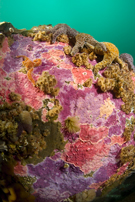
Ochre stars (Pisaster ochraceus) walk arm in arm atop sheets of
encrusting hydrocoral (Stylantheca porphyra). This shot illustrates the
best and worst aspects of a camera lens with a 180 degree viewing angle.
Certainly, to cover this subject which is actually inside a narrow crack, an
exceptionally wide view is needed. However, the flat subject is obviously
distorted into something that looks like a globe. Furthermore, the bottom
corners, by virtue of their distance from the camera, are not illuminated by the
camera's strobes.
"Middle Farallon", Farallon Islands, California
June 24, 2006
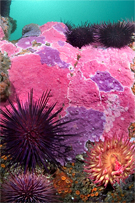
Encrusting hydrocoral (Stylantheca porphyra), red sea urchins
(Strongylocentrotus franciscanus), and a white-spotted anemone
(Urticina lofotensis). Stylantheca lives in places that experience
mind-bogglingly brutal wave action. The rocks around these particular colonies
are smooth an polished. It's most certainly something to be appreciated when the
seas subside enough to get a glimpse of scenes such as this one.
"Middle Farallon", Farallon Islands, California
April 24, 2005
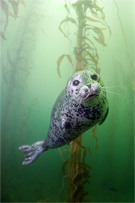
Harbor seals (Phoca vitulina) seem to expend almost no effort as they
glide through the kelp forest. However, it's uncommon to get a view like this
one. These animals, even when in the mood to play, will almost always approach
such that a would-be photographer doesn't see them coming. There was a little
bit of chicanery and a fair bit of luck involved in getting this pup to pose
like this.
"Tanker Reef", Monterey Bay, California
September 24, 2005
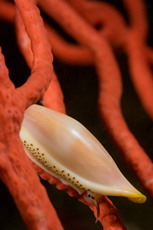
Often, when I show a picture to a non-diving friend, the first question they ask
is "How deep were you when you took that?". The implication, of course, being
that the deeper the depth, the better the photograph must be. This, then, is the
very best photograph on the site. This simnia, Delonovolva aequalis,
lives on red gorgonians(Lophogorgia chilensis). If you'd like to see one
in the Monterey area, you'll have to make a relatively deep dive. This picture
was taken 120ft. At this depth, the photographer's senses were impaired the
equivalent of two and a half glasses of scotch. Likely this photograph would not
have been taken at all had not the boat's anchor landed smack on top of this
very gorgonian. To be sure, this squished the subject somewhat, but also reduced
the photographer's drunkard walk (or, swim) towards the dive's turnaround point
to a voyage of only inches. In truth, diving to this depth without the benefit
of helium in one's breathing gas isn't very smart. I'm actually a little
surprised I didn't get distracted and start taking pictures of the leprechauns
also commonly seen after about 100ft.
"Deep Shale", Monterey Bay, California
February 17, 2007
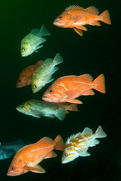
Vermilion (Sebastes miniatus), kelp (S. atrovirens), and copper
(S. caurinus) rockfish just kind of hanging out. Rockfish spend a lot of
time doing this, usually around some place that has shelter from predators. This
aggregation is right above a deep, but narrow recess in the shale substrate.
It's plenty big enough for any of these fish, but still far too small for the
likes of the resident harbor seals.
"Shale Island", Monterey Bay, California
August 27, 2006
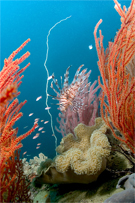
Lionfish, (Pterois sp.). Lionfish spines contain some really nasty venom.
The photographer had a pit in his stomach and fear in his heart as he took this
shot. It wasn't the fish pictured that was the cause for concern, but, rather,
its identical twin hovering disturbingly close to the photographer's bare cheek.
I suspect I would have let this shot go if Golden Dawn skipper Craig de
Wit had recited his account of being stung by a blue-spotted stingray before we
did this dive rather than after. It seems that pretty much everything underwater
in New Guinea is capable inflicting pain. It was weeks after I returned home to
San Francisco before my hands, swollen and raw from twelve days of incidental
contact with various stinging nasties, healed completely.
"Wewak and Madang", Papua New Guinea
August 21, 2005
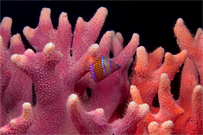
Jewel top snails (Calliostoma annulatum) are one of the many animals that
can be found in the branches of California hydrocoral (Stylaster
californicus).
"Forgotten Pinnacle", Carmel Bay, California
December 11, 2004
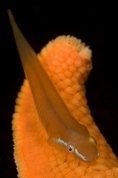
This kelp clingfish (Rimicola muscarum) has taken on a reddish hue to
blend in with a bat star (Asterina miniata). Perhaps this is an effective
defense against predators. However, their most effective defense against
photographers is to simply hop on to any camera that comes within a few inches
of them. Should a thwarted photographer then be foolish enough to closely
inspect a Rimicola that's decided to perch on his camera, it's likely
that this little fish will then attach itself somewhere on the photographer's
torso. It's remarkably hard to locate one's subject once this has happened. I
usually don't even try.
"Tanker Reef", Monterey Bay, California
November 11, 2006
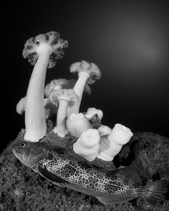
I spent a little time fussing with various pictures I'd taken, converting them
to black and white. I quickly discovered that while this seemed like a good
idea, the results usually look rather wretched. So, I decided that maybe I
should be thinking about black and white while still in the water. This is the
first shot I took with black and white conversion in mind. Metridium
farcimen and lingcod (Ophiodon elongatus) are both high contrast
elements. Of course, I would have liked a wonderful sunburst in the background,
but conditions didn't provide for this. Instead, I got a sun-blob.
"Hopkins Deep Reef", Monterey Bay, California
February 11, 2007
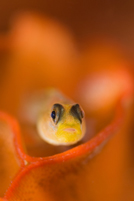
Blackeye gobies (Coryphopterus nicholsi) spend most of their time resting
on some surface, waiting for something interesting to happen.
"Anchor Farm", Monterey Bay, California
March 3, 2007
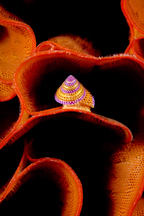
A jewel top snail (Calliostoma annulatum) cruising through a colony of
bryozoans. If you look closely, you may notice the individual bryozoan polyps.
This shot takes advantage of something that's usually a great source of
frustration for the underwater photographer. Since light that's in-line with
the camera lens produces excessive backscatter, strobes are almost always
positioned off to one side. However, this makes it difficult to illuminate the
interior of holes like the ones you see here. In this case, most everything of
interest is near the lip of each hole and the unilluminated recesses contrast
nicely with the rest of the image.
"Anchor Farm", Monterey Bay, California
March 10, 2007
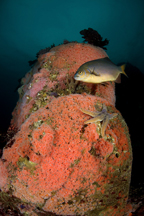
The top of Eric's pinnacle is covered in Corynactus californica. This
area is in somewhat pristine shape despite the hoards of divers that come here.
I suspect that a misplaced fin here or there isn't much compared to the fury
winter storms inflict upon things in such shallow depths. Striped perch
(Embiotoca lateralis) such as this one can be found almost anywhere a
Monterey diver may venture.
"Eric's Pinnacle", Monterey Bay, California
February 10, 2007
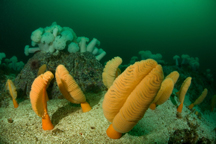
Fleshy sea pens (Ptilosarcus undulatus) and Metridium farcimen.
"Hussar Point", Browning Pass, British Columbia
September 6, 2006
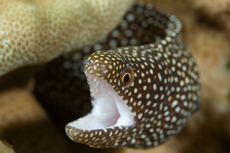
Moray eels like this whitemouth moray (Gymnothorax meleagris) assume an
open-mouth posture in order pump water across their gills. Such behavior may
look aggressive, but it's just the animal breathing. Then, of course, there are
times when morays really are making a threating display -- that's what this is.
Nice teeth.
"Kona", Hawaii
January 4, 2007
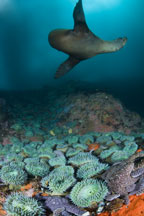
A California sea lion (Zalophus californianus) turning his nose up at the
photographer. The giant green anemones (Anthopleura xanthogrammica) in
the foreground live primarily in impact areas. It should be no surprise then,
that the dark regions of in the distant background are caused by witewater
blocking out the sun.
"Lobos Rocks", Big Sur, California
December 3, 2006
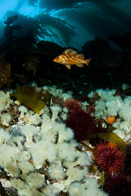
A small copper rockfish (Sebastes caurinus) hanging out in shadow of some
bull kelp.
"Snowfall", Browning Pass, British Columbia
September 4, 2006
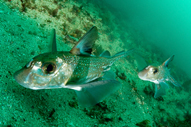
A couple of young male spotted ratfish (Hydrolagus colliei) out cruising
Dillon Rock. You can bet that they're up to no good.
"Dillon Rock", Shushartie Bay, British Columbia
September 6, 2006
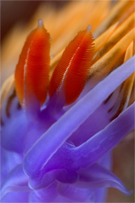
Close-up of a spanish shawl (Flabellina iodinea).
"Tanker Reef", Monterey Bay, California
April 2, 2006
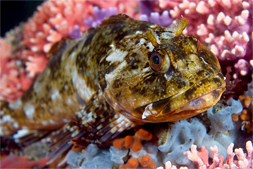
Cabezon (Scorpaenichthys marmoratus) rely heavily on camouflage. This
one, however, is easily spotted against a backdrop of California hydrocoral
(Stylaster californicus). These fish have something of a split
personality. Frequently, they bolt in terror when a diver is as much as 30 feet
away. At other times, even when it's quite obvious they've been spotted, they
seem perfectly happy to be an object of close inspection. Some of the most
extreme examples of this latter behavior occur in the early part of the year
when males establish their nests. The animal pictured here was not keeping watch
over eggs, but nonetheless seemed content to stay put. In July, when this
photograph was taken, East Pinnacles is overgrown with Eisenia and other
algae. This makes both finding interesting subjects and taking photographs a bit
more challenging. To take this particular shot, the photographer had to hold
back a bouquet of Eisenia fronds with his forearm at the same time as he
was positioning the camera and illuminating the subject with a cannister light.
It was more than just a little frustrating and was, in fact, the last straw that
led to the purchase of a real focus light which presumably allows for such
pictures to be taken while using only two hands instead of requiring three.
"East Pinnacles", Carmel Bay, California
July 17, 2005
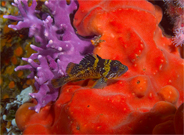
A young China rockfish (Sebastes nebulosus) nestles between a colony of
California hydrocoral (Stylaster californicus) and an unidentified red
sponge. One could say that this picture was actually several months in the
making. I had my eye on this sponge and hydrocoral colony for quite some time.
It's a striking background, but doesn't appear to be a particularly popular
hangout for interesting foreground subjects. Eventually, one day sunny July day
with pedestrian water clarity I ran across this cute little China. It should
have been a fantastic opportunity, but the heavy surge and the animal's
exceptionally skittish disposition made things difficult. The hole this guy was
using as refuge provided excellent protection from the glaring strobes of
inquisitive photographers, however it lacked a hideaway small enough to keep out
a lingcod or other predator. This might explain why I've not run across this
fish since my initial encounter. Interestingly enough, little is known about the
habits of juvenile China rockfish. In fact, there seems to even be some debate
about what very young ones even look like!
"East Pinnacles", Carmel Bay, California
July 16, 2005
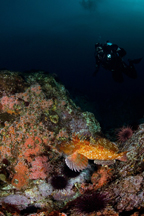
Cabezon (Scorpaenichthys marmoratus) and Mark Lloyd
"Middle Farallon", Farallon Islands, California
February 3, 2007
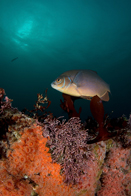
Striped perch (Embiotoca lateralis) and club-tipped anemones
(Corynactus californica).
"Eric's Pinnacle", Monterey Bay, California
February 10, 2007
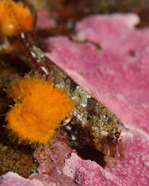
Snubnose sculpins (Orthonopias triacis) are common throughout central
California.
"Middle Farallon", Farallon Islands, California
March 4, 2007
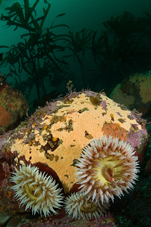
Fish-eating anemones (Urticina piscivora) are beleived to live for
hundreds of years. This is a good hing, since it took me almost that long to get
the lighting right on this shot. Though these anemones are quite common,
specimens well positioned for photographers are few and far between.
"Inner Pinnacles", Carmel Bay, California
September 24, 2006
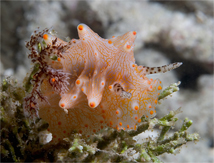
This is Halgerda batangas. If you're not a slug geek, this might not be a
very helpful description. Yes, this is a slug. More specifically, it's type of a
dorid nudibranch. The black tree-like structure at left is the animal's gill
plume. The two cylindrical projections at the right are sense organs called
rinophores.
"Wewak and Madang", Papua New Guinea
August 19, 2005
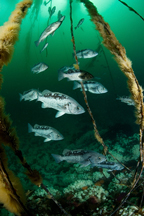
Black rockfish (Sebastes melanops) form their own schools in northern
lattitudes. In contrast, in Monterey, they seem to be found resting on the
bottom or tagging along with blue rockfish schools.
"Hussar Point", Browning Pass, British Columbia
September 6, 2006
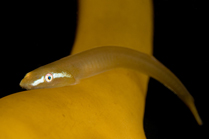
This kelp clingfish (Rimicola muscarum) is, not surprisingly, clinging to
a stipe of giant kelp (Macrocystis sp.). Clingfish are not uncommon, but
have rather cryptic habits and are therefore often overlooked. I spent the
better part of a 150 minute dive shooting this one 3cm fish -- do I know how to
party or what?. As is often the case, I noticed something in the shots once I
got home that I didn't notice during the dive. In this instance, it was that the
subject was changing it's color to match its background. I considered the
possibility that it was only the reflection of strobe light off the background
that created the appearance of different cameleon colors. However, I've now
dismissed this possibility because the color seems to be uniformly applied to
the entire animal, even to parts not backed by something reflective. I've also
found at least one source in the literature that cites the ability to change
color by another member of the genus Rimicola.
"Tanker Reef", Monterey Bay, California
November 11, 2006
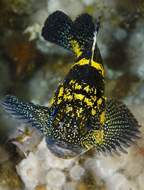
Though usually quite bashful, China rockfish (Sebastes nebulosus) may
occasionally be lured out into the open if one is careful to keep ones distance
and avoid any movement that could be construed as threatening. It took four
dives over two days to get this fish to come out from its crevice. This animal's
odd name derives from their popularity as a food fish among asians.
"Arena Rock", North Coast, California
June 4, 2006
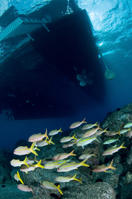
Geesh, in Hawaii, even ship propellers are fabricated in the likeness of
Plumeria. There's just enough water under the Kona Aggressor II
for these yellowfin goatfish (Mulloidichthys vanicolensis). This is
pretty typical for Kona diving. The shoreline drops away quickly so most of the
anchorages are in pretty close to shore. This one is downright scary.
"Kona", Hawaii
December 31, 2006
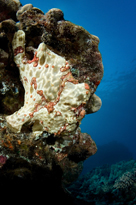
It's difficult to find creatures stranger than frogfish. This, of course, makes
them popular among photographers. The nice thing about this Commerson's frogfish
(Antennarius commerson) is its relatively large size. This affords
wide-angle zealots like myself the opportunity to create a shot with some nice
water and coral in the background.
"Kona", Hawaii
January 1, 2007
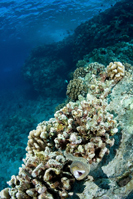
Whitemouth moray (Gymnothorax meleagris) on an ascetic reef.
"Kona", Hawaii
December 31, 2006
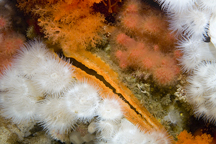
Arena rock is just jam-packed with invertebrate life. The orange "lips" in this
picture are actually the mantle of a rock scallop (Crassedoma giganteum).
The bulbous clumpy soft coral is a sea strawberry (Gersemia rubiformis).
These contrast with the white of the anemone, Metridium senile.
"Arena Rock", North Coast, California
June 4, 2006
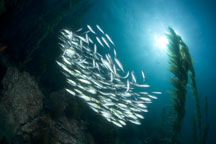
Jack mackerel (Trachurus symmetricus) being indecisive about which way to
go.
"Indian Rock", Santa Catalina Island, California
November 25, 2006
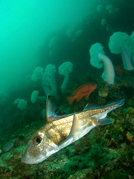
One of British Columbia's stranger inhabitants, spotted ratfish (Hydrolagus
colliei) are closely related to sharks.
"Dillon Rock", Shushartie Bay, British Columbia
September 6, 2006
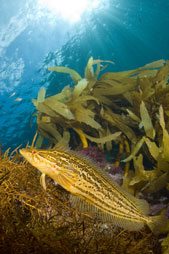
Giant kelpfish (Heterostichus rostratus) quietly inhabit the shallows of
Catalina.
"Indian Rock", Santa Catalina Island, California
November 25, 2006
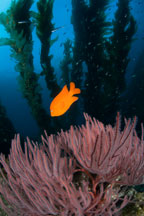
Southern California's most celebrated underwater photo subject, the garibaldi
(Hypsypops rubicundus) is seen here framed by a red gorgonian
(Lophogorgia chilensis) and giant kelp (Macrocystis sp.)
"Eagle Reef", Santa Catalina Island, California
November 24, 2006
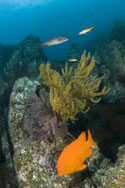
Garibaldi (Hypsypops rubicundus) and reef scene.
"Eagle Reef", Santa Catalina Island, California
November 24, 2006
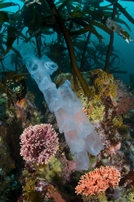
This is one of Monterey's more common pelagic salps. If you know your Latin,
you'll likely understand how this animal's mouth-like orifice lead to it's name.
Members of the greater population, however, usually find that their first
encounter with Thetys vagina leaves them with a raised eyebrow or two. I
suspect most people arriving at this page via Google are more than a little
disappointerd.
"Local's Ledge", Carmel Bay, California
November 19, 2006
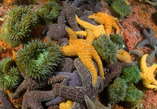
Ochre stars (Pisaster ochraceus) and giant green anemones (Anthopleura
xanthogrammica) encrust impact zones at Lobos Rocks.
"Lobos Rocks", Big Sur, California
August 19, 2006
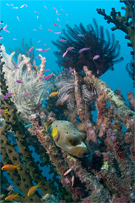
This blackspotted puffer (Arothron nigropunctatus) appears to have chosen
an odd perch. It may have been looking for a cleaning from some gobies that were
in the area. The feathery crinoids seen in the background are ubiquitous in New
Guinea and assume a vast range of colors. Crinoid arms can be quite sticky, and
clumsy divers may find their wetsuits decorated with one or more animals upon
returning to the boat.
"Wewak and Madang", Papua New Guinea
August 20, 2005
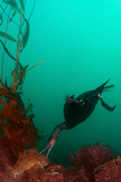
This Brandt's cormorant (Phalacrocorax penicillatus) has it in mind to
make a meal out of this adult cabezon (Scorpaenichthys marmoratus) who's
guarding a nest full of eggs. As you can see, cabezon are not the smallest of
fishes when fully grown.
"Tanker Reef", Monterey Bay, California
January 13, 2007
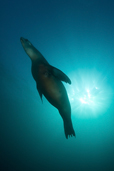
A california sea lion (Zalophus californianus) and a late afternoon sun.
"Local's Ledge", Carmel Bay, California
November 19, 2006
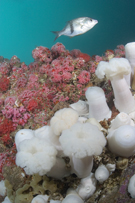
Pile perch (Damalichthys vacca), club tipped anemones (Corynactis
californica) and giant plumed anemones (Metridium farcimen). Days in
which the water is clear enought to take pictures with minimal backscatter and
this large a depth of field are not common inside Monterey Bay.
"Ballbuster", Monterey Bay, California
December 17, 2005
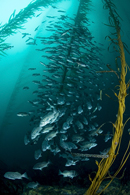
Blue rockfish (Sebastes mystinus) pack into tight schools when currents
are running. Although difficult to photograph, this is most certainly one of my
favorite scenes. The local sea lions seem to like these dense aggregations as
well. Watch such a school for a few minutes and you'll likely see the entire
mass dart toward the reef in fright as one or more of our furry friends
approach. Interestingly enough, the sea lions appear to do this as much for
their own amusement as for any other reason
"Outer Pinnacles", Carmel Bay, California
August 13, 2006
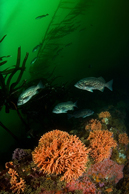
California hydrocoral (Stylaster californicus) and blue rockfish
(Sebastes mystinus). Like many of us, blue rockfish are fairly averse to
doing more work than they need to do. The fish in the background of this shot
are hiding in the lee of a stalk of kelp so that they don't have to swim against
the current. It might seem surprising that a fish would need to do this.
However, your average reef fish isn't really built for long extended swims. And,
of course, rockfish seem to spend a great deal of their lives running away from
the local pinnipeds. I imagine they appreciate the odd opportunity to take it
easy for a bit.
"Outer Pinnacles", Carmel Bay, California
August 20, 2006
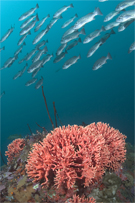
California hydrocoral (Stylaster californicus) and blue rockfish
(Sebastes mystinus).
"East Pinnacles", Carmel Bay, California
January 22, 2006
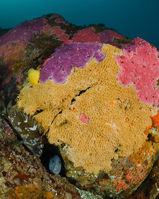
Encrusting hydrocoral (Stylantheca porphyra), wolf eel (Anarrhichthys
ocellatus) and gopher rockfish (Sebastes carnatus).
"Middle Farallon", Farallon Islands, California
February 4, 2007
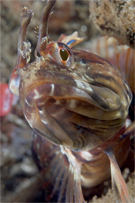
An unusually cooperative onespot fringehead (Neoclinus uninotatus) poses
for a portrait. These fish are seldom seen out in the open. Usually they tuck
everything but their head into a hole where it can't be seen. You can imagine my
surprise when I stumbled across a pack of onespot fringeheads hunting out in the
open. The group made attempts to eat just about everything in sight. Shrimp,
several nearby ronquils, even rocks if they even vaguely resembled something
more animate. I suspect that the shrimp were the menu item of choice. Certainly,
the little crustaceans were quick to vacate their holes when a fringehead
approached. More definitive proof was a red and white banded shrimp antenna
dangling from the mouth of one of the hunters. Surprisingly, a full mouth didn't
prevent this fish from seeking out additional prey.
"Shale Island", Monterey Bay, California
March 4, 2006
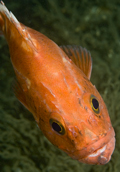
If you order "red snapper" on the west coast, you'll most likely get one of
these. Yelloweye rockfish (Sebastes ruberrimus), however, are a
remarkably poor choice of food fish due to their exceptionally slow rate of
reproduction. Amazingly enough, these fish can live to be well over a hundred
years old. That is, of course, unless they end up in your fish tacos instead.
"Arena Rock", North Coast, California
June 3, 2006
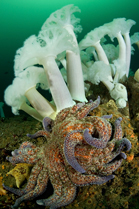
Visitors to Hopkins Deep Reef will immediately notice both the giant plumed
anemones (Metridium farcimen) and the sunflower stars (Pycnopodia
helianthoides). Sun stars most often assume a rather mundane posture. This
one, however, appears to have taken up some form of yoga. Sun stars, are, in
fact quite pliable. Hold one in your hand (above water, that is), and, apart
from the fact it's pretty much impossible not to rip off a number of the
animal's tube feet, you'll notice that they drape over your hand like a wet dish
towel.
"Hopkins Deep Reef", Monterey Bay, California
August 13, 2006
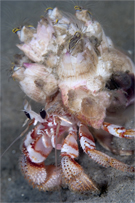
Blackeyed hermits (Pagurus armatus) often move quickly and with seeming
purpose. Likely, this is the reason why they're popular hosts for freeloading
barnacles such as the ones seen here. Of course, tracking a speeding crab with a
long focal length lens can be difficult. And, true to popular conceptions of
crab disposition, these hermits quickly tire of posing for pictures and are apt
to protest by hunkering down in an unphotogenic stance.
"Breakwater", Monterey Bay, California
February 4, 2006
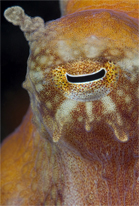
Few creatures appear as other-worldly as octopuses. One of many puzzling
postures red octopuses (Octopus rubescens) assume involves periscoping
their eyes like this.
"Shale Island", Monterey Bay, California
February 11, 2006
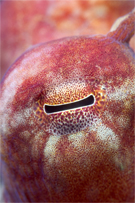
I find the rectangular pupils of octopuses a little hypnotic. It's hard not to
assume some intellegence is at work behind eyes like these. While generally
considered nocturnal and inhabitants of sandy areas, red octopuses (Octopus
rubescens) such as this one are commonly seen during the day in areas with a
shale bottom.
"Shale Island", Monterey Bay, California
April 9, 2006
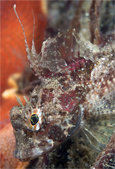
A spotfin sculpin (Icelinus tenuis) shows off some outrageously long
dorsal spines. Elongate fish can be difficult to photograph well. I find shots
in which an eye tracing the subject from nose to tail ends at the edge of the
picture to be somewhat abrasive. The obvious tricks to prevent this are shooting
head on so that the fish's tail is in the shot and/or using a shallow enough
depth of field that the subject is well out of focus where it meets the
picture's edge. In this shot, a different trick is used. The face and long
dorsal spines of the sculpin are highlighted against the bat star in the
background. Where the fish's body meets the edge of the shot however, the body
blends in with the background. I could claim that this was entirely intentional,
but that would be less than true. When shooting this, I was completely focused
on getting the bat star behind the sculpin's head and spines and wasn't really
thinking about anything else. As such, I had low expectations for this shot and
didn't even realize it was anything of value until I got home.
"Breakwater", Monterey Bay, California
March 19, 2006
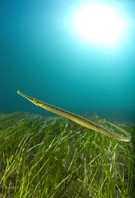
The neighbor's kid spent the better part of an afternoon tossing this garden
snake across his lawn. Just kidding, this is a pipefish (Syngnathus sp.)
swimming over a bed of surf grass. A pipefish's shape is obviously problematic
for photographers. If the entire animal is in the frame, then it's not easy to
make out features like an eye or mouth. What's a photographer to do? Well, one
thing that helps is to compose a shot with other elements -- in this case, a
sunburst and surf grass. It's easy to fill up a flash card with garbage shots
when you're trying to take a picture like this. It's what I would call a "hard
work " shot. It's painstaking to shoot, and there's little guarantee you're
going to come away with something you like. Often, as with this shot, you find
that it would have been better to use some different camera setting than what
you used. Of course, there's always next time. I'll likely work on this
particular shot again, next time I find myself at Catalina.
"Hen Rock", Santa Catalina Island, California
July 1, 2006
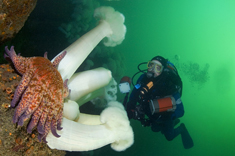
A sunflower star (Pycnopodia helianthoides) on the move near some
Metridium farcimen. Chuck Tribolet was kind enough to pose, completing
the scene.
"Hopkins Deep Reef", Monterey Bay, California
May 14, 2006
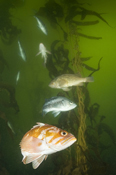
Proof that you can still have fun in four foot visibility. Yes, there are
certainly challenges to taking pictures in water that resembles oobleck
(remember your Seuss?), but I'm actually quite fond of the Mountain Dew
background that only the most intense plankton blooms cause. Here, a variety of
rockfish can be seen at various distances into the muck. From front to back: A
copper rockfish (Sebastes caurinus), a black rockfish (Sebastes
melanops), and a brown rockfish (Sebastes auriculatus). The latter is
also commonly called a Bolinas after the Marin county town which is presumably
host to a large number of them. Bolinas (the town), of course, is far more
famous for other things. Most of all, this sleepy surfing town is famous for its
dislike of visitors. In an ongoing battle with CalTrans, Bolinas residents are
quick to remove any and all highway signs which might aid in locating the town.
Paradoxicly enough, however, should you pass all the hurdles placed before you
and successfully navigate to Bolinas, some of the local shops will be more than
happy to sell you a T-shirt emblazoned with the likeness of the "Bolinas 2mi"
highway sign which wasn't on the highway to mark the appropriate exit.
"Tanker Reef", Monterey Bay, California
July 30, 2006
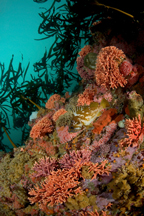
A gopher rockfish (Sebastes carnatus) followed me around with the
expectation that I'd stir up something good to eat. This common fish behahvior
always gives me pause. One wonders if the fish would follow any large animal or
if one has given it reason to beleive one will be crashing in to things. A sure
way to stop such an unwanted shadow is to point a camera at it. This fish was
quick to dart into some California hydrocoral (Stylaster californicus).
"Local's Ledge", Carmel Bay, California
September 30, 2006
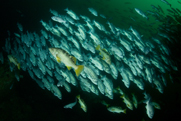
This olive rockfish (Sebastes serranoides) is bucking the trend set by
his blue rockfish (Sebastes mystinus) peers. Likely the camera got a
little too close for comfort.
"Ballbuster", Monterey Bay, California
October 15, 2006
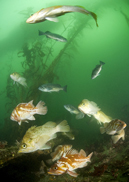
This is my entrant in the "How many different species of rockfish can you fit in
a single photograph?" competition. I think there are five different members of
the genus Sebastes here. That is, blue (S. mystinus), kelp (S.
atrovirens), copper (S. caurinus), black and yellow (S.
chrysomelas) and the fairly uncommon, at least for the Monterey area, brown
(S. auriculatus). There are actually two specimens each of the last two
species, but all four fish are fairly well hidden.
"Tanker Reef", Monterey Bay, California
July 23, 2006
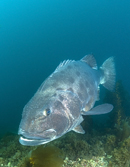
Giant (black) sea bass (Stereolepis gigas) surprise me every time I see
them. Something about them seems so improbable. They look more or less like any
number of reef fish, but they're monstrously large, several-fold the size of the
photographer. Not that I haven't seen large animals underwater. I've had an
extended encouinter with a gray whale and one with a whale shark. However, one
expects animals of this nature to be massive. A bass on the other hand, well, I
guess my mind just expects a bass to be something quite modest. At around 400
lbs, this is the largest sea bass I've encountered. I believe this to be a
female about to spawn. Certainly, she was quite popular among other sea bass in
the area. I find it hard to look at the virtual metropolis of parasites running
around on the heads of sea bass without feeling a little pity or the urge to
grab hold of the bass and dislodge the freeloading passengers. I'm pretty sure
that an attempt to perform such an altruistic act would be misinterpreted.
"Italian Gardens", Santa Catalina Island, California
July 1, 2006
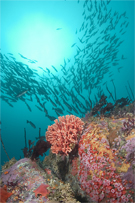
California hydrocoral (Stylaster californicus) and blue rockfish
(Sebastes mystinus) cradle a sunburst. When shooting wide angle, cold
water photographers often prefer to look directly at the sun like this. While
the photographer may get a little bleary-eyed watching a backlit scene, the
camera's autofocus appears unaffected. The increased background light makes it
easier to achieve a picture with balanced lighting.
"East Pinnacles", Carmel Bay, California
January 22, 2006
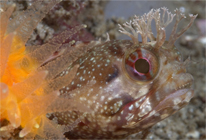
It's often quite difficult to figure out the scale of subjects in underwater
photographs. If the photographer is taking pictures of something quite small,
like this yellowfin fringehead (Neoclinus stephensae), and wants everyone
viewing the picture to know the scale, then, it's a good idea to include some
kind of reference item in the shot itself. This image uses an orange cup coral
(Balanophyllia elegans) for this purpose. While the cup coral, like the
fringehead, is likely unfamiliar to the viewer, the transparency of its arms are
an almost sure indication if its size.
"Tanker Reef", Monterey Bay, California
April 15, 2006
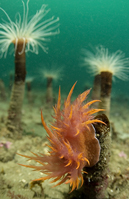
Rainbow nudibranchs (Dendronotus iris) feed on tube anemones
(Pachycerianthus fimbriatus). The thing that frustrates me most about
rainbow nudibranchs is that they're almost always in a posture such that their
head is not clearly defined.
"The Barge", Monterey Bay, California
July 4, 2006
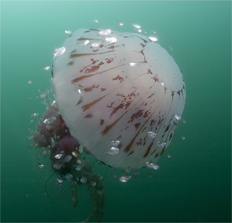
Young pacific pompano (Peprilus simillimus) engulf a purple jellyfish
(Pelagia colorata).
"Flintstones", Big Sur, California
July 30, 2005
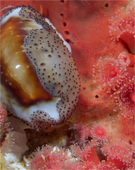
Most people's experience with cowries is limited to seeing napkin holders
fashioned from the tiger cowries found in the south pacific. Thankfully for
them, chestnut cowries (Cypraea spadicea) are a little small for use in a
table setting. While I find their exposed mantle and polished shell interesting,
I seldom shoot pictures of them since they seem to have an affinity for boring
backgrounds. This one was kind enough to pose with some Corynactis
californica and a bright red sponge.
"Granite Point Wall", Carmel Bay, California
April 2, 2006
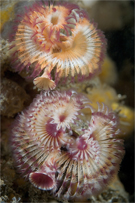
If Dr. Seuss engineered a tube worm, I suspect he might have come up with
something like these two Surpula vermicularis. A classic, example of an
animal that is ubiquitous but seldom photographed, surpulids retreat into their
calcerous tubes should a would-be photographer so much as cast a shadow in their
vicinity. Not surprisingly, shots like this one can be something of an extended
project. I'll likely return to this spot to work on it some more.
"Tanker Reef", Monterey Bay, California
April 15, 2006
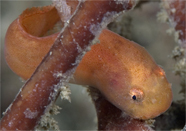
This showy snailfish (Liparis pulchellus) lacks the purple stripes
displayed by other specimens. However, I think this animal's oddly scalloped
upper lip still makes it a worthy photographic subject.
"Tanker Reef", Monterey Bay, California
February 4, 2006
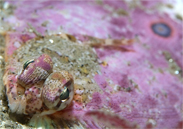
C-O soles (Pleuronichthys coenosus) are named for a distinctive pattern
on their caudal fin that looks like (yup, you guessed it) the letter "C"
followed by the letter "O". This one has gone a little crazy trying to match the
color of some coralline algae. The color scheme makes it appear the animal's
pectoral fin is, in fact, the tail of some smaller fish with gigantic, bulbous
eyes. Unfortunately for me, this is something I didn't notice until I sifted
through the day's pictures -- I dismissed this as a worthy subject prematurely
"Tanker Reef", Monterey Bay, California
April 15, 2006
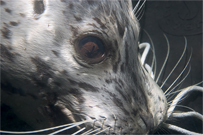
Ever seen a harbor seal (Phoca vitulina) tie a pair of shoes? . . . Me
neither. However, as this photo demonstrates, they are quite adept at UNtying
them. Other harbor seal skills (not pictured) include a knack for removing masks
and drysuit hoods, and, a disturbing ability to dislodge boat anchors from their
resting place in the sand.
"Tanker Reef", Monterey Bay, California
September 18, 2005
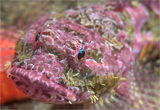
Coralline sculpins (Artedius corallinus) have a great crocodile smile.
"Shale Island", Monterey Bay, California
April 1, 2006
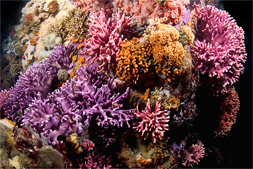
California hydrocoral (Stylaster californicus) is usually found in places
with high current or surge. Like many hydrocoral pictures, this one was taken
as a "fly by" as the photographer rode the surge in a narrow channel between two
boulders.
"East Pinnacles", Carmel Bay, California
December 18, 2004
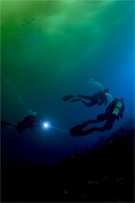
Clinton Bauder, David Chamberlin, and Craig de Wit under a billowing cloud of
muddy river water. Cold, opaque river water is slow to mix with the Bismark
sea's salt water. As such, on this dive, I couldn't see my hand when I pressed
it against my mask at a depth of 10 feet. Below a depth of about 40 feet,
however, the water was a beautiful blue.
"Wewak and Madang", Papua New Guinea
August 18, 2005
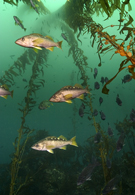
Olive rockfish, (Sebastes serranoides) and blue rockfish (Sebastes
mystinus) often school together. In this photograph, one can see the
boundary between warmer, murky, plankton-rich water above and clearer, colder
water below. Fishwatching enthusiasts should note that olive rockfish appear
nearly identical to yellowtail rockfish (Sebastes flavidus). A high
resolution version of this photograph was sent to rockfish expert, Dr. Milton
Love for identification.
"East Pinnacles", Carmel Bay, California
July 3, 2005
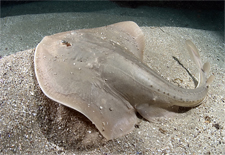
When disturbed from rest, thornback rays (Platyrhinoidis triseriata)
demonstrate the graceful wing rippling they use for propulsion.
"Eric's Pinnacle", Monterey Bay, California
January 8, 2005
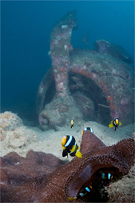
Clark's anemonefish (Amphiprion clarkii) and B-25 wreck
"Wewak and Madang", Papua New Guinea
August 21, 2005
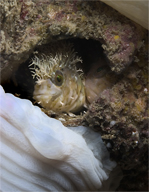
These mosshead warbonnets (Chirolophis nugator) inhabited this empty
barnacle for several weeks before they disappeared. An octupus moved into the
vacated residence soon after.
"Hopkins Deep Reef", Monterey Bay, California
December 24, 2004
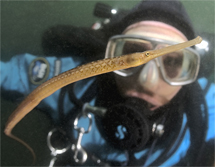
Clinton Bauder takes a close look at a pipefish (Syngnathus sp.).
"Tanker Reef", Monterey Bay, California
January 15, 2006
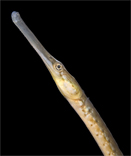
In the silted out conditions of my first dive with a camera, this pipefish
(Syngnathus sp.) was, in fact, the only fish I even saw. Thankfully,
pipefish are horrible swimmers, and, as such, often have little choice but to be
cooperative photographic subjects.
"Anchor Farm", Monterey Bay, California
November 14, 2004
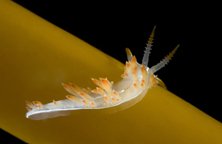
This three-lined aeolid (Flabellina trilineata) is cruising along a stipe
of giant kelp (Macrocystis sp.) in search of prey.
"McAbee Beach", Monterey Bay, California
July 16, 2006
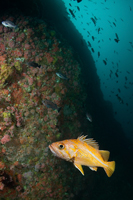
A canary rockfish (Sebastes pinniger) rises from the depths into a school
of its blue rockfish (Sebastes mystinus) cousins. The first time I dove
the pinnacle I was impressed by the density of encrusting life. It's likely the
result of the stiff currents here. On the dive on which this shot was taken, the
current went from light to outrageously strong and back in about an hour.
"Orca Pinnacle", Big Sur, California
August 27, 2006
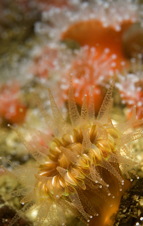
Brown cup coral (Paracyathus stearnsi) with club tipped anemones
(Corynactis californica).
"Shale Island", Monterey Bay, California
July 15, 2006
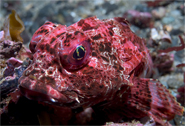
I originally mistook this bull sculpin (Enophrys taurina) for the very
similar buffalo sculpin (Enophrys bison). The latter is commonly seen by
divers in the Pacific Northwest, but would have been quite unusual to see in
Carmel Bay. Despite the initial misidentification, the sighting of this fish was
still of interest. This is, in fact, the only bull sculpin I have ever seen.
"Whaler's Cove", Carmel Bay, California
September 5, 2005
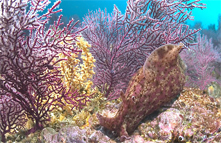
California sea hare (Aplysia californica) and purple gorgonians
(Eugorgia rubens) with zoanthid anemones (Parazoanthus
lucificum?). Even when aided by a picture, sea hares can be difficult to
describe to someone who has never seen one. In fact, they're even quite puzzling
when you have one in your hand.
"Coral Reef", Anacapa Island, California
January 1, 2005
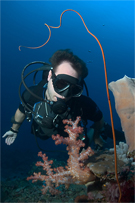
David Chamberlin looking at some invertebrates. If you look closely, you may be
able to see the goby resting the this sea whip. Not surprisingly, I didn't see
this little guy when the shot was taken.
"Wewak and Madang", Papua New Guinea
August 20, 2005
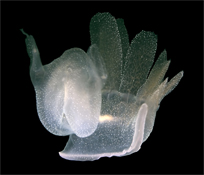
Lion's mane nudibranchs (Melibe leonina) are frequently seen swimming in
open water.
"Tanker Reef", Monterey Bay, California
January 30, 2005
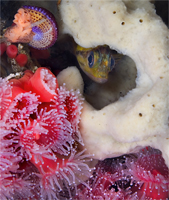
A young China rockfish (Sebastes nebulosus) hides in sponge surrounded by
club-tipped anemones (Corynactus californica) and a jewel top snail
(Calliostoma annulatum).
"Forgotten Pinnacle", Carmel Bay, California
December 4, 2004
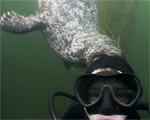
Self-portrait of me having something of a bad hair day. Yes, I had a horrible
headache after this dive. This rather interesting harbor seal (Phoca
vitulina) behavior isn't nearly as threatening as it appears. On one
occasion, however, a seal managed to work a tooth under the stitching of my
drysuit hood. This gave the animal an excellent purchase and a battle for
possession of my hood (and mask!) ensued.
"Tanker Reef", Monterey Bay, California
October 8, 2005
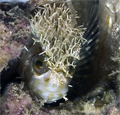
Having seen this finger-sized mosshead warbonnet (Chirolophis nugator) on
several consecutive outings to the same location, the photographer decided to
dive for a day using a camera lens suitable only for subjects of this size. This
decision proved unfortunate when the photographer found himself holding a
useless camera in the company of an exceptionally inquisitive 30 ft. gray whale.
"Hopkins Deep Reef", Monterey Bay, California
December 24, 2004
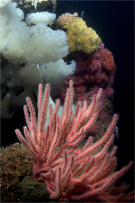
Red gorgonians (Lophogorgia chilensis) contrast nicely with white giant
plumed anemones (Metridium farcimen).
"Deep Shale", Monterey Bay, California
April 16, 2005
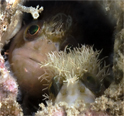
A mosshead warbonnet (






























































































































